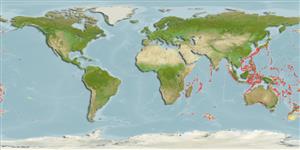>
Perciformes/Scorpaenoidei (Scorpionfishes) >
Triglidae (Searobins) > Pterygotriglinae
Etymology: Pterygotrigla: Greek, pterigion, diminutive of pteryx = wing, fin + Greek, trigla, es = red mullet (Ref. 45335).
Environment: milieu / climate zone / depth range / distribution range
Ecologia
marino batidemersale; distribuzione batimetrica 300 - 500 m (Ref. 95016). Deep-water
Indo-West Pacific: Maldives, Madagascar, southwest India, and coast of Mozambique, East Africa; north to Japan; southward to Taiwan, the Philippines, northern Australia off Queensland and Western Australia.
Size / Peso / Age
Maturity: Lm ? range ? - ? cm
Max length : 20.0 cm TL maschio/sesso non determinato; (Ref. 559)
Short description
Morfologia | Morfometria
Spine dorsali (totale): 7 - 10; Raggi dorsali molli (totale): 11-13; Raggi anali molli: 11 - 13; Vertebre: 26 - 27. This species is distinguished by the following characters: long (17-24% SL) and wide snout; snout and head with depressed profile (15-30°); antrorse rostral spine absent; rostral spines long and slender (10-28% SL); bucklers at base of D1 fin, no spines along D2 fin bases (Ref. 95016).
A rare deepwater species (Ref. 9771). Found on the continental shelf and continental slope (Ref. 75154).
Life cycle and mating behavior
Maturità | Riproduzione | Deposizione | Uova | Fecundity | Larve
Richards, W.J. and T. Yato, 2014. Revision of the subgenus Parapterygotrigla (Pisces: Triglidae: Pterygotrigla). Zootaxa 3768(1):23-42. (Ref. 95016)
IUCN Red List Status (Ref. 130435)
Threat to humans
Harmless
Human uses
Informazioni ulteriori
Nomi ComuniSinonimiMetabolismoPredatoriEcotossicologiaRiproduzioneMaturitàDeposizioneSpawning aggregationFecundityUovaEgg development
Age/SizeAccrescimentoLength-weightLength-lengthLength-frequenciesMorfometriaMorfologiaLarveDinamica popolazioni larvaliReclutamentoAbbondanzaBRUVS
BibliografiaAcquacolturaProfilo di acquacolturaVarietàGeneticaElectrophoresesEreditarietàMalattieElaborazioneNutrientsMass conversion
Strumenti
Special reports
Download XML
Fonti Internet
Estimates based on models
Preferred temperature (Ref.
123201): 2.2 - 13.9, mean 10.4 °C (based on 169 cells).
Phylogenetic diversity index (Ref.
82804): PD
50 = 0.5000 [Uniqueness, from 0.5 = low to 2.0 = high].
Bayesian length-weight: a=0.01259 (0.00515 - 0.03077), b=3.01 (2.79 - 3.23), in cm total length, based on LWR estimates for this (Sub)family-body shape (Ref.
93245).
Trophic level (Ref.
69278): 3.6 ±0.5 se; based on size and trophs of closest relatives
Resilienza (Ref.
120179): Medio, tempo minimo di raddoppiamento della popolazione 1.4 - 4.4 anni (Preliminary K or Fecundity.).
Fishing Vulnerability (Ref.
59153): Low vulnerability (10 of 100).
